Safe hand washing rules
The flip side of the holiday is cleaning after a feast - you have to wash and clean mountains of dishes, wash and iron tablecloths, wash the kitchen. Oftentimes, the thought of washing dishes keeps us from inviting friends or a large number of guests. Maybe it's better to go to your friends or invite them some other time?

The best thing is, of course, to have a dishwasher! For several reasons, it would be nice to convince the husband of the need for such a unit in the kitchen: it is estimated that when using a dishwasher, a family of four saves more than 200 hours a year; it saves time and money on detergents. Washing dishes in the machine is about half the price, since you do not need to soap every item. The skin on the hands will stop cracking and peeling, and the nails will not exfoliate.
In the meantime, you have not convinced your husband, use our tips for organizing hand-washing dishes, taking into account modern realities.
There are many types of dishwashing soap on sale, for example, household soap, "Hostess". Grate a bar of soap on a fine grater, put the shavings in a plastic bottle and fill with water. Make a hole in the lid and use soapy water when washing dishes.
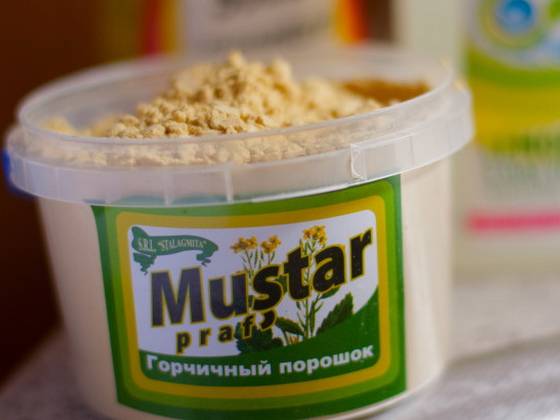
There is also such a proven, cheap, harmless means for safe dishwashing, like dry mustard: 1 tbsp. l. for 1 glass of water. It has a degreasing effect even when washed with cold water. Baking soda is often used to wash dishes.
There is a huge range of modern dishwashing detergents on sale: Cinderella, Pemolux, Fairy, Comet, Gala, powder and liquid. All of them perfectly degrease dishes, with their help it is easy to wash off dried food debris.
Some powdered cleaners contain abrasive materials. Aluminum and Teflon utensils cannot be cleaned with these products. Abrasive particles can scratch the thin film on the surface of aluminum cookware, which prevents the aluminum from oxidizing.
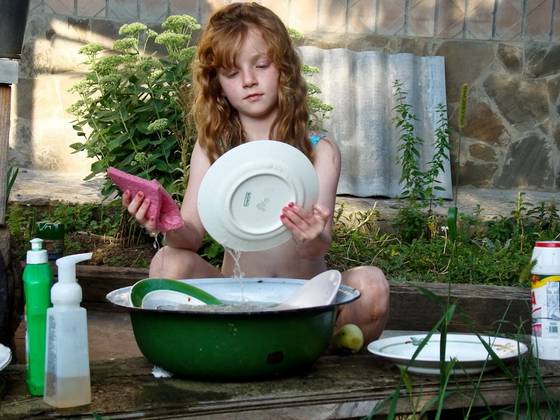
Abrasive cleaning products contain fragrances, alkaline additives, and sometimes disinfectants. These drugs are usually available in the form of powders or pastes. And although glycerin or similar substances are added to the composition of these detergents, which not only prevent the preparations from drying out, but also soften the skin of the hands, always wear rubber gloves when using them.
Depending on the type and purpose of cleaning agents, their packaging and packaging may be different. You can choose not only the most suitable for the purpose, but also in convenient packaging. You must think in advance where you will store these drugs: put them in a cupboard, leave them close at hand or on the kitchen shelf.
There are a lot of dishwashing detergents, and the list is growing. Choose the tools that are right for you.
The procedure for cleaning from blackness
If everything is clear with soot, we are preparing: something stuck, something stuck, something burnt, then why the aluminum pan darkened inside and how to clean it.
Limescale often occurs on the surface of the dishes if the water in the house is hard.
The pan has darkened from improper use or from time to time, but you still have to clean the black plaque. Here are some ways to do it:
- Table vinegar or apple cider vinegar. We moisten a soft cloth in liquid and three pan inside, rinse the pan with warm water after the procedure and wipe it dry.
- Kefir, yogurt, fermented baked milk. Not a bad option for bleaching pots. The exposure time is a couple of hours. Just pour and leave, and then pour out the liquid and rinse the dishes. You don't have to rub and apply physical force at all.
- Sour milk, cucumber pickle.You need to use the method in the same way as in the previous case.
- Apple. You need to cut the fruit in half and rub the aluminum coating with a cut until the spots disappear.
- Sorrel. Just pour a couple of bundles of water, put on fire, boil for about 40 minutes. At the end, rinse the pan with detergent, rinse with running water.
- Carbonated drinks (Coca-Cola, Fanta, Sprite). A more modern method, but it has a right to life. We pour and wait for a while.
- Lemon. The same procedure as with an apple.
Using the above methods, you should only be guided by the level of contamination of the dishes. If everything is very sad, increase the time of exposure to contact between metal and alkaline agents. Or repeat the procedure.
Chemistry in the fight against dirt and plaque on cupronickel
It is not always possible to achieve the desired result with foil, eggshells, and even vinegar and baking soda. In especially neglected cases, one has to resort to "heavy artillery" based on chemical compounds.
Before processing, products are washed in warm soapy water. Clean surfaces while still warm with a cotton pad.
A proven way to bring back the shine and shine to devices is electrolysis. We are talking about a galvanic cleaning method, which gives 100% results, but is associated with certain difficulties. To carry out electrolysis, a working current source is required.
You can build a device for such cleaning with your own hands at home. To do this, proceed according to the following scheme:
- the glass container is filled with water;
- place cupronickel products there;
- additionally put any metal object in the dish.
- a minus is connected to the product requiring cleaning, plus to a metal auxiliary product.
The processing time is adjusted depending on the voltage. The higher it is, the faster the cupronickel surface will become clean again. So, for example, at a voltage of 24 V, products will sparkle clean in just one minute.

How to properly wash a cauldron
Knowing how to wash the cauldron after cooking will help you quickly return to its original appearance.
After cooking pilaf
A cauldron properly prepared for work does not need special cleaning
It is important for the first time before cooking pilaf to ignite the pot with oil and wipe it thoroughly with a rag. A special, natural protective film forms on the walls of the dishes, preventing food from burning
In the future, the cauldron is washed as follows:
- Free the dishes from food debris.
- Pour the cauldron with water, boil and leave to cool.
- Rinse the dishes with warm water with a soft sponge (you can use liquid detergents).
- They wipe the dishes dry, then rub a drop of oil along the walls of the cast-iron dish and send them for storage with the lid open.
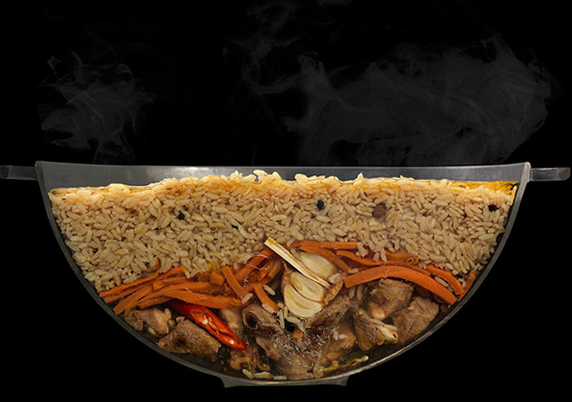
 Before washing the cauldron, you need to remove all food debris from it.
Before washing the cauldron, you need to remove all food debris from it.

In the field
To quickly wash a dirty cauldron on a hike, the following tips will help:
- Ignite the dishes with sand. To do this, a dirty cauldron is filled to the brim with fine river sand and left overnight on the coals of a fire. In the morning, the dishes are removed from the heat, allowed to cool slightly, sand is poured.
- Heat the cauldron with salt. For this cleaning method, the dishes are filled with salt (two packs are enough), after which the dishes are calcined over low heat. The signal that the cauldron can be removed from the fire will be darkened salt and fat that has disappeared from the walls of the dishes.
 Annealing with sand
Annealing with sand Calcining with salt
Calcining with salt
Mechanical cleaning
The mechanical cleaning method is only suitable for old cast iron utensils. Today's thin pans and pans with different coatings are all too easily damaged.
For mechanical cleaning, you will need a sharp knife, a metal dish scrubber, and hot water. You can add detergent or abrasive powder to the water. If the dishes are made of cast iron, aluminum or metal, they can be preheated to a temperature of 200-250 degrees.The heat will burn all fat residues. After cooling, the dishes are immersed in warm water with diluted cleaning agent and the carbon layer is scraped off with a sharp knife. The remainder is removed with a metal sponge.
The fastest method of mechanical cleaning is with a special wire brush attachment for a drill. With its help, you can easily and almost instantly get rid of pots from multi-layered carbon deposits. To do this, you need to put the attachment on the drill and, plugging the drill into an outlet, brush along the sides and bottom of the dishes. In a few minutes, the kitchen utensils will shine like new.
Folk ways
The combination of PVA glue and laundry soap has proven itself well. This method is suitable for all types of pots. Removes old black carbon deposits and restores shine. The process looks like this:
- To prepare the solution, pour 4 liters of clean water into a large saucepan or metal bowl. Add a grated bar of 72% laundry soap and a tablespoon of PVA glue.
- Boil contaminated utensils in this solution for half an hour.
- Then clean off the remaining carbon deposits with a metal or ordinary (if the dishes are enameled) sponge.
You can use soda ash to clean enameled dishes. Small dirt is cleaned with a sponge with the addition of soda, dishes with serious carbon deposits will need to be boiled and only then cleaned. Aluminum dishes cannot be cleaned in this way, they will darken.
Aluminum cookware can be perfectly cleaned with vinegar. Lightly soiled dishes are poured with 9% vinegar for several hours and cleaned with a hard washcloth. Old multilayered carbon deposits are removed by boiling dishes with the addition of half a glass of vinegar and grated laundry soap.
Salt can be used to clean small dirt in aluminum pans. Apply the product to a sponge and wipe the bottom and sides.
Cookware is in direct contact with food. That is why it is necessary to regularly cleanse it from traces of fat and plaque. Otherwise, bacteria quickly multiply both inside and on the walls of the dishes, along with food entering the human body.
Master class on cleaning cupronickel
To test the method of home cleaning of cupronickel with soda and foil, old knives were taken. The knives were covered with a dark coating, as well as a copious layer of old fat.

Pre-treatment with detergent, a toothbrush and warm water did not give any results, cupronickel knives remained dark and scary in appearance.
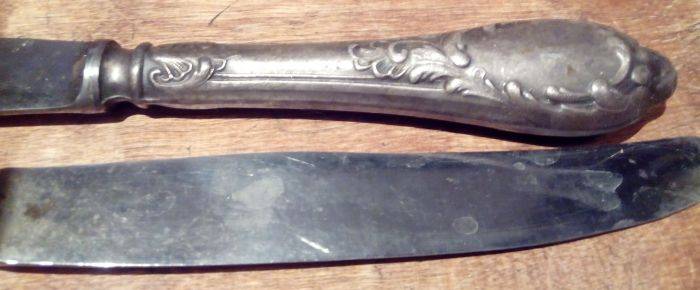
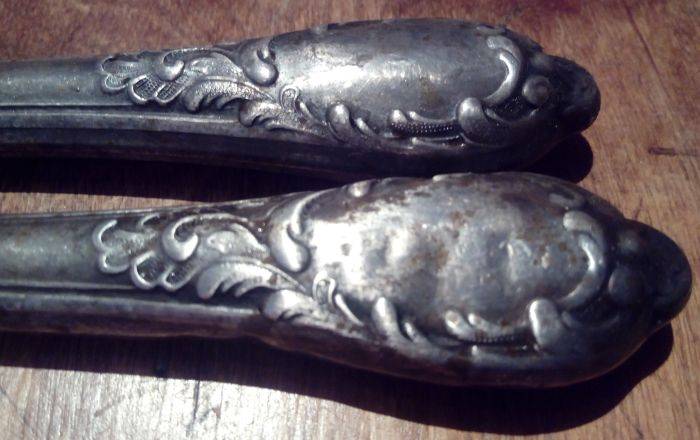
To carry out the global cleaning work, we needed a large saucepan, foil, soda and the knives themselves. The pan had to be taken very large so that sufficiently long knives could fit on its bottom. The most common foil was used, which is in the inventory of every housewife.

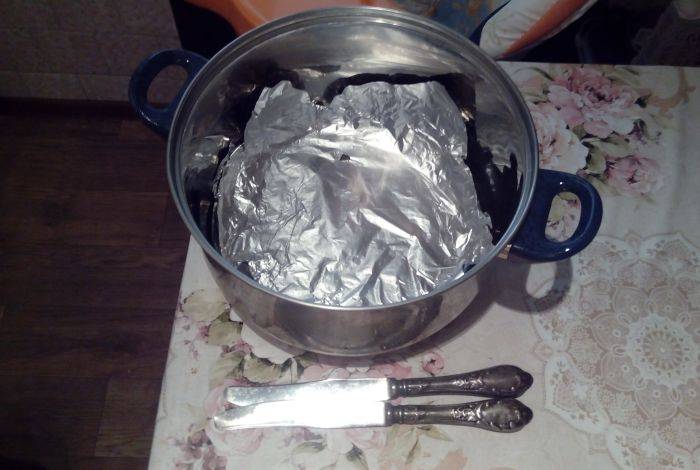
Cover the bottom of the pan with foil, add baking soda and knives. You can additionally salt and add Pemolux powder, which will help in the fight against fat.
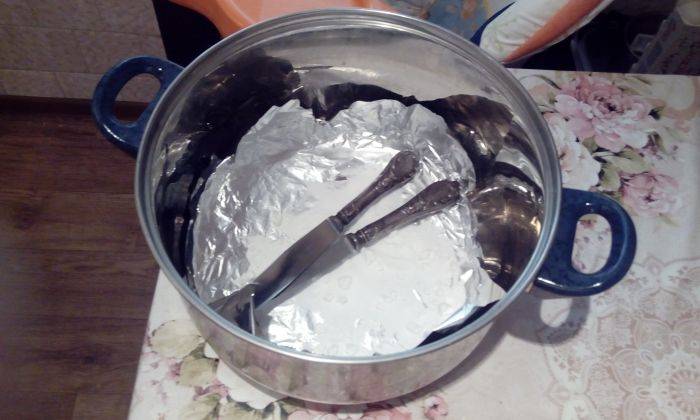
Fill the knives on foil with a cleaning compound with boiling water or plain water, turn on the gas and boil for a while. In this case, we poured boiling water over it and boiled it for 15 minutes. Note that if you add Pemolux to the water, then you should be on the alert and control the fire level so that the foam formed inside the pan does not escape.
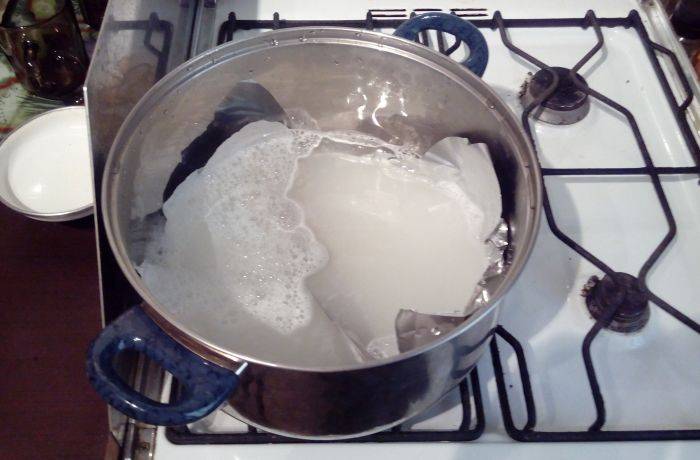

After a short boil, the contents of the pan are drained. It remains only with a brush to clean the residues of dirt from the cupronickel knives. You can wash the knives exclusively in clean warm water, or you can use additional detergent to achieve maximum results.


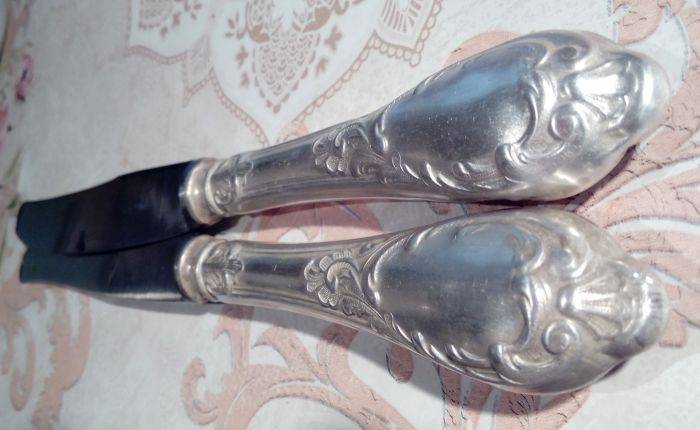
In this case, the processing was not carried out with particular care, but at the same time the final result was good.
How to wash a cauldron after cooking
Porous alloy dishes do not like aggressive cleaning. The pores are clogged with detergent, the surface will have to be rinsed for a long time with running water.The oily non-stick layer is destroyed.
How to wash a cauldron? After cooking, the food is laid out in another dish, it cannot be stored in porous metal, the dishes will acquire an unpleasant smell. After pilaf, other dishes that are well steamed, it is enough to remove food debris from the vessel. After that, it is enough to wash the utensils with warm water without detergents, wipe well. If in this way it was not possible to achieve the expected result, water is poured into the massive utensils to 1/3 of the depth, brought to a boil, covered with a lid. All fat particles are then perfectly removed with a foam sponge.
To wash the aluminum cauldron, you can use ordinary dishwashing detergents that do not contain aggressive acids and alkalis.
Aluminum utensils are easier to clean. To wash it, you can use ordinary dishwashing detergents that do not contain aggressive acids and alkalis. Previously, the places of burning from the inside are greased with a gruel of salt or mustard powder. Outside, a cauldron used over an open fire is cleaned of soot using traditional methods:
- River sand with grass;
- Coarse salt;
- Ash.
At home, the cauldron is pre-soaked in soapy water, immersed completely in a large container. After that, they are well cleaned under hot water, rinsed, and wiped dry.
It is best to wash a cast iron cauldron with hot water without soap.
How to wash a cast iron cauldron? Hot water is best without soap. If it is not possible to remove all contamination with water, the correct way to clean cast iron involves gentle washing while maintaining an oily protective layer:
- Mild detergents;
- Dry mustard;
- Soda.
It is necessary to restore the anti-corrosion layer after washing - just wipe the cauldron from the inside with an oiled napkin or cloth.
With proper care, the cauldron will last for years.
It is important to protect the vessel from excess moisture: rusty spots form on the cast iron; harmful fungi multiply on the aluminum surface. For long-term storage, it is better to wrap the dish in cotton or linen cloth
With proper care, the cauldron will last for years. What kind of dishes to choose - everyone decides for himself. Aluminum utensils are lighter than cast iron. You can take it with you to nature. Cast iron retains heat longer, food languishes in it, becomes tasty. You have learned how to clean the cauldron quickly and correctly. Take care of the dishes, following our advice, please your loved ones with delicious pilaf and other dishes!
Enamel cookware
Enamelled metal utensils are resistant to salts and acids, hygienic, easy to clean, can be used not only for cooking, but also for long-term storage. You should not cook second courses in it (especially porridge), as they often burn and spoil the enamel.
If the enamelware is still hot, do not pour cold water into it: the enamel may deteriorate.
The enameled dishes are washed with a solution of baking soda (25 g per 1 liter of hot water), and then rinsed with clean water.
If milk or any other food burns in an enamel bowl, pour water into it, put a little baking soda and boil. After that, the burnt food will easily come off the bottom and sides of the pot.
To remove scale from the walls of enameled dishes, it is necessary to boil water with vinegar in it for one and a half to two hours (1 tablespoon of 5 tablespoons of vinegar or 2 tablespoons of essence).
Enamel dishes can be cleaned with a cotton swab dipped in vinegar.
Alternative methods according to "grandmother's" recipes
To clean cupronickel dishes at home from improvised means, the remains of eggshells are often used. The mixture formed from 3-4 eggs will be enough to make a paste.
Before use, the shell is finely pounded to form a powder, poured with water and put on fire, bringing to a boil. Cupronickel products are placed in a decoction and "boiled" for 5-15 minutes, depending on the degree of contamination. After cleaning, wipe the dishes dry.

A well-known remedy for the care of precious and semi-precious metals is toothpaste. It can be used to clean cupronickel utensils in combination with cotton pads. The process will take time, effort, patience and accuracy. It will be especially difficult to clean products with complex designs and delicate weaves.
One of the extraordinary methods of cleaning cupronickel alloy is with the help of potato broth. It is prepared from potatoes in their skins. Cupronickel products are immersed in a boiling broth and allowed to boil for at least half an hour. You can boil products without fear of damage until traces of plaque and dirt begin to disappear from the surface, after which they are rinsed and wiped off.
You can replace the paste with tooth powder, if you first dilute it in a small amount of water until a soft mass is formed. For processing small parts, use cotton swabs dipped in a paste of powder or toothpaste.
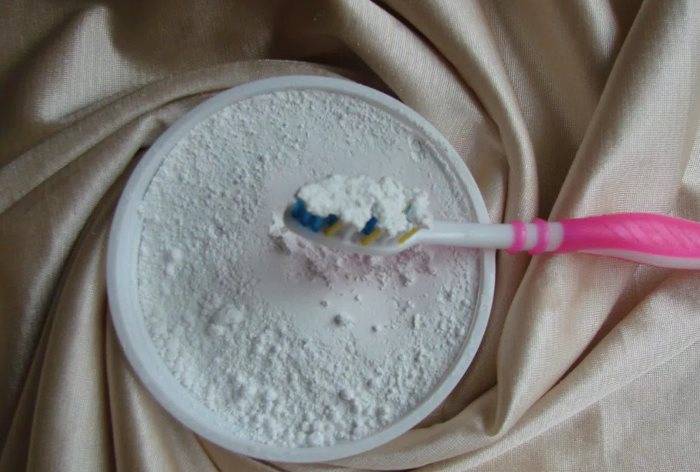
Effective methods of descaling
Scale is a constant "companion" of samovars and teapots. To remove such plaque, both folk remedies and household chemicals are suitable.
Folk remedies
Folk remedies can remove both fresh and old traces of scale. After processing the inner walls, it is recommended to boil and drain the water, after which the samovar can be used for its intended purpose.
Organic acids
In the fight against scale, succinic acid helps, which needs to be filled 2/3 of the samovar and heated to 70 degrees. Then you need to prepare a mixture of 50 grams of this raw material and a liter of water. This composition must be poured into a samovar and left for 3 hours. Citric acid is capable of removing scale. To clean the plaque, you will need 50 grams of this raw material and cold water. After that, the mixture is boiled and drained.
Table vinegar
To remove old traces of plaque, you must first boil a soda solution (2 tablespoons per liter of water), and then vinegar.
To clean the samovar, you can use the tools designed to remove scale in the teapot. There is a wide range of such products on the market.
Differences in cleaning cast iron from aluminum
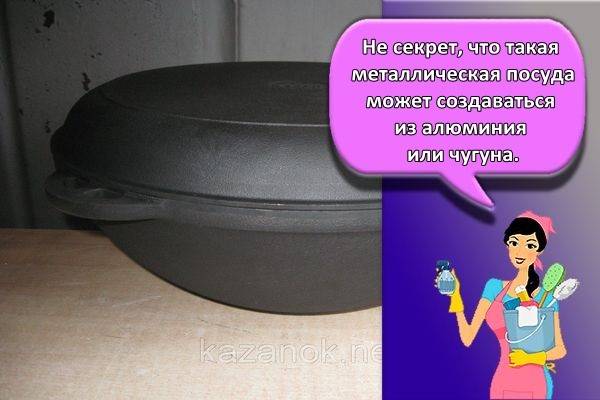
Aluminum
Aluminum cookware can be cleaned in three ways.
Dishwasher
Products made of aluminum can be cleaned from dirt using conventional dishwashers. This is the simplest way of washing cauldrons, when using which a person does not need to spend a lot of time and effort. Simply place the dirty aluminum container in the dishwasher, pour in the detergent and select the appropriate setting. After washing, the washed cauldron is wiped with a towel and dried.
Harsh abrasives, metal scouring pads
Special abrasives will help to remove the carbon layer, which also effectively fight against corrosion. These tools include:
- drill with grinding attachment;
- sandpaper;
- iron sponge.
To remove dirt or carbon deposits from the surface, it is necessary to treat it with a cleaning powder. Then it is rubbed into the surface with one of the listed abrasives.
Oxalic acid-free detergents
Most often, detergents are used to remove dirt from aluminum dishes. Some people think that any means can be used, but this is not the case. It is contraindicated to clean cauldrons with liquids containing oxalic acid. It reacts with aluminum, making its surface dull.
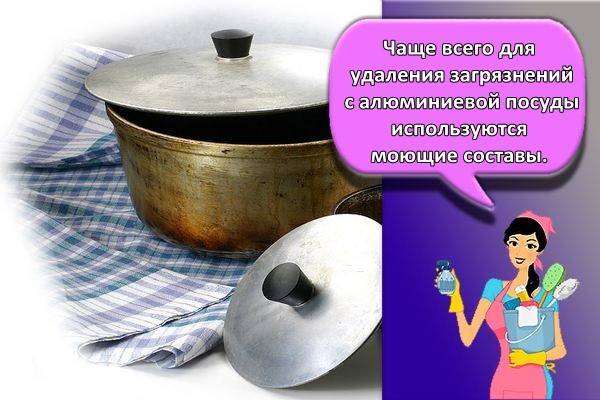
Cast iron
There are four features that distinguish cast iron from aluminum.
May crack from falling
Cast iron is considered a durable material, but this does not mean that it cannot be damaged. The main disadvantage of cast iron products is that they are damaged when dropped
Therefore, it is necessary to use cast iron cauldrons very carefully so that they do not accidentally fall and do not split when hitting a hard surface.
Requires bluing
To protect the cast-iron coating from damage and dirt, a bluing procedure is carried out. In the process of its implementation, the cast-iron surface is treated with boiled oil. This is done so that the inner coating of the cookware is covered with a non-stick and anti-corrosion layer. Over time, bluing has to be repeated to restore the protective coating.
Machine wash is not allowed
Do not use dishwashers to remove dirt from cast iron. After washing cast iron products in dishwashers, their surface is covered with corrosion. Therefore, when cleaning the cauldron, it is necessary to use other, no less effective methods of removing carbon deposits.
Care rules
To achieve the ideal condition of silver jewelry and other items made of this noble metal, it is necessary to provide them with proper care.
Frequency of cleaning
On contact with air, the metal is often covered with a dark coating. It is a silver sulfide that forms through oxidative reactions. Plaque is not considered a defect and does not indicate poor product quality. It can be easily removed by using different means. The frequency of cleaning procedures is selected individually. On average, it is 3-4 weeks.
What not to use
Care is advised during the cleaning procedure. For this, it is forbidden to use compositions that include abrasive particles.
Also, sharp objects cannot be used to remove plaque.
General rules
To avoid darkening of silver, you should follow these rules:
- take off jewelry before showers and baths, doing wet cleaning or washing dishes;
- do not wear silver jewelry in the sauna, pool, sports training;
- do not wear such products after applying cosmetics or perfume;
- clean silver from dirt in time to avoid the formation of stains and streaks;
- do not wash silver dishes in the dishwasher.
Detergent overview
Today, a large number of effective formulations are known that allow you to quickly and effectively cleanse silver.
Soda
To do this, it is enough to mix baking soda with water and wipe the silver jewelry with a soft cloth. There is also a milder method. For this, silver should be dipped in a soda solution. After a few hours, it is recommended to rinse it with water and wipe it with a soft cloth.
However, the most effective is the technique with the use of foil. You can also use an aluminum pan. It is recommended to bring 1 liter of water to a boil and add 2 large tablespoons of baking soda. Immerse the product in the resulting solution for a quarter of an hour. After which they will begin to shine. Instead of soda, you can safely use salt or combine these funds in equal parts.
Soapy water
Before cleaning silver jewelry, you can rinse it with warm soapy water. This method will help get rid of the dirt. Otherwise, the cleaning agent may react with dirt. As a consequence, there is a risk of getting unwanted results.
Ammonia
Liquid ammonia will help to eliminate darkening. If the products are not too dirty, it is enough to immerse them in a solution consisting of 2 large spoons of ammonia and 1 liter of water. It is worth keeping the silver in the liquid for a quarter of an hour. You can also wipe the jewelry with a rag soaked in such a solution.
To get rid of stubborn plaque, it is recommended to add a small amount of washing powder to the ammonia solution. Silver should be well rinsed in the resulting liquid, and then rinsed thoroughly with water.
In addition, ammonia can be effectively mixed with hydrogen peroxide. It is recommended to take these components in equal parts and immerse the product in the resulting product for a quarter of an hour. Small objects can be rubbed with a mixture of chalk and ammonia. These components are mixed to a state of gruel.
Acid
To purify silver in this way, it is recommended to use a 6% vinegar solution. You can also take a 10% citric acid solution. Products should be rubbed with a cloth soaked in the product. It is also acceptable to dip them in lemon juice. After a few minutes, the products should be thoroughly rinsed.
It is permissible to boil coins and other items that have darkened strongly in a solution of formic or sulfuric acid. Its concentration should be 5%. Recently, Coca-Cola and other drinks containing orthophosphoric acid have often been used for this purpose.
Potato
A simple method of purifying silver is the use of potatoes. To do this, simply immerse the item in water with chopped raw potatoes. It should be kept in liquid for several hours. To enhance performance, the product can be rubbed. The water in which the potatoes were boiled is perfect. It is worth placing a piece of foil in it.
Garlic husk
To cleanse silver, you will need a lot of concentrated decoction of garlic peels. To prepare it for 500 milliliters of water, it is recommended to take 2 small spoons of raw materials. Immerse a silver piece in the solution and boil it. Depending on the severity of the contamination, the procedure can take up to 30 minutes.
How to wash crystal dishes by hand (with video)
Sometimes a green coating forms inside the crystal decanters. How to get rid of it? Before washing the dishes by hand, pour some warm water into the carafe, add 1 tbsp. l. vinegar and let stand for 2 hours. Then add a handful of fine fresh sand and shake vigorously several times, then rinse the decanter well. You can rinse the decanter with a solution of baking soda and ammonia with the addition of crushed eggshells.

Never wash glassware with detergent, much less a wire washcloth. There are special detergents for washing such dishes. The detergent can be made by yourself: collect remnants and immerse them in water with a small amount of ammonia for 2 hours. Then mold one piece of soap from the pieces and put it in a nylon stocking (it will be more convenient to use this way.)
Glass vases, glasses and jars are well washed with water with the addition of 1-2 teaspoons of vinegar and 1 teaspoon of salt. When washing glass glasses, add a pinch of baking soda to the water and then let them dry without wiping them off with a towel. The glasses will be transparent.
To remove dried wine residue from the bottom of a narrow glass or carafe, fill it with warm soapy water and leave overnight. In the morning, add slightly moistened baking soda to a decanter and shake well. To make the crystal decanter shine and sparkle, wipe it with a woolen cloth with a pinch of blue starch.
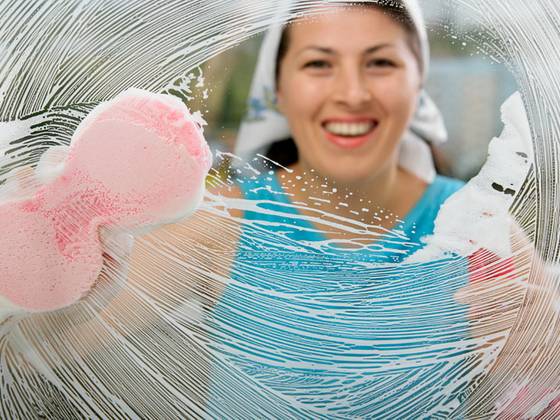
Try to wash vases and decanters with a narrow neck using finely chopped egg shells or pieces of paper, you can also use coffee grounds. Add detergent and shake the carafe vigorously several times. But today there is a wide variety of ruffs and brushes on sale.
Crystal that has lost its shine, wipe with raw potatoes, then rinse with cold water with the addition of blue.
By the way, it is best to wipe glass and crystal glasses, wine glasses and goblets with paper napkins - there are no small lint left.
Watch how to wash dishes in the video, which shows all the subtleties of organizing this hygienic process:
How to clean properly
Proper care will allow you to wear the accessory for several years. The first thing to consider is the texture of the material. The bag can be made of smooth leather, corrugated or even high-quality leatherette, which also needs to be looked after.
Smooth
To properly care for smooth skin, you need to have a special soft tissue in stock. It can be moistened, but dry cleaning is also a good way to deal with minor contamination.If the stains are large, you can use a regular dish sponge and soapy water. For wet cleaning, a weak solution of citric acid is used, which is prepared based on the proportions of 1 teaspoon per 1 liter of water. After cleaning is completed, wipe the leather accessory with a dry, clean cloth.
Leatherette with a fleecy surface
Most often, bags made of nubuck or velor have a fleecy surface. Such material looks very attractive, however, it requires maintenance. To remove rain stains, as well as greasy stains and accumulations of dust, you must use a special soft brush.
One teaspoon of alcohol is diluted in a glass of water, after which the bag is wiped with a soft cloth.

Lacquer handbag
In order for the lacquer accessory to retain its elegant and luxurious look as long as possible, it is recommended to wear it only in warm weather, but not in heat and cold. With constant wearing at temperatures below -15 and above +25 degrees, elasticity is lost, and the skin cracks. To clean the varnish from stains and maintain a presentable appearance, it is recommended to use only special creams and aerosols.
With aging effect
At first glance, artificially aged materials may seem easy to wear, but some nuances also need to be observed. Such a bag repels moisture well and is easy to restore. If a large, indelible stain appears, it is enough just to rub it well with a coarse material, and wipe off the stain along with the coating. However, it is recommended to store the ladies' accessory in a dark place so that the leather does not crack even more.
Embossed models
Today, embossed versions that mimic the shape of a reptile's skin are popular, but they need special care. You need to wipe the product with a damp cloth soaked in alcohol, it is not recommended at home.
Features of care for different materials
The selection of cleaning agents is carried out based on the materials from which the elements of the shower stall are made. For cleaning, it is useful to purchase tools that facilitate washing:
- hygroscopic cloth;
- foam sponge;
- a rubber or soft plastic scraper for cleaning water.
Glass and acrylic
All housewives know how to handle glass. The glass walls are cleaned with common window and mirror products. This material is difficult to scratch and ruin, the main thing is to get rid of stains with special means. Plastic cab walls are more difficult to clean. Small cracks are clogged with dirt, the material loses its transparency, becomes cloudy. Use soft fabrics and scrapers, special agents for synthetic glass.
The acrylic coating is lightweight and comfortable, but requires special care. The surface is quickly scratched, amenable to the action of chemicals. The acrylic tray loses its smoothness from falling bubbles, friction. When choosing products for cleaning acrylic, they are guided by the manufacturer's advice.
Metal
The metal parts of the sanitary ware are washed without abrasive powders. Lime deposits from the mixer and other steel elements are dissolved with special compounds.
Enamelled surface
Enamel coatings are among the easiest to maintain. The cabin pan covered with enamel is cleaned with any means - gel, powder, solution. It is not difficult to remove even old dirt, but it is not worth putting off washing for a long time. Fresh stains are easier to clean.
Tile
The tile is washed with a conventional ceramic cleaner. The main difficulty is the seams, in which moisture and dirt accumulate, the fungus quickly multiplies, forming mold. To wash the tiles, you should use special products containing an antifungal component.
To avoid difficult washing during cleaning, splashes of shampoo, toothpaste, shaving products are washed immediately after use, until they become old and become stubborn dirt.
Chrome steel
Faucets, door hinges, nozzles are cleaned with a mild agent that dissolves plaque.It is better to use sprays that are easy to apply evenly over the entire surface. Chrome-plated steel does not tolerate metal meshes, brushes, hard brushes. Scratches caused by hard impact quickly overgrow with dirt, the shine fades.
Painted aluminum
The cab frame is covered with paint, which is erased from careless handling, revealing the aluminum. Use soft cloths with detergent for cleaning.
It is applied for a couple of minutes, then washed off with water and wiped dry. Powders with abrasives are not used for the framework.
How to restore cupronickel
Cupronickel are cup holders, dishes, jewelry (earrings, rings), coins, candlesticks. You can clear cupronickel and get rid of any contaminants using available tools, such as vinegar, ammonia. These products do not harm metal at all, do not cause corrosive processes, if cleaned correctly.
Table 1. How to properly clean cupronickel dishes with folk
by means
| Ingredient used |
Photo |
Preparation of funds |
How to clean cupronickel |
 |
Mix 2-5 tbsp. l. soda (based on the degree of pollution) in a liter of water | Put the accessories in the product and hold for 2-3 hours. If they are very dirty, use a sponge or toothbrush to gently scrub off the dirt. | |
 |
Use in its original form. Use vodka or rubbing alcohol | ||
 |
Prepare a broth by boiling the shells of 2-3 eggs in a liter of water | Place cupronickel dishes in a boiling broth for 20 minutes and wash with clean water | |
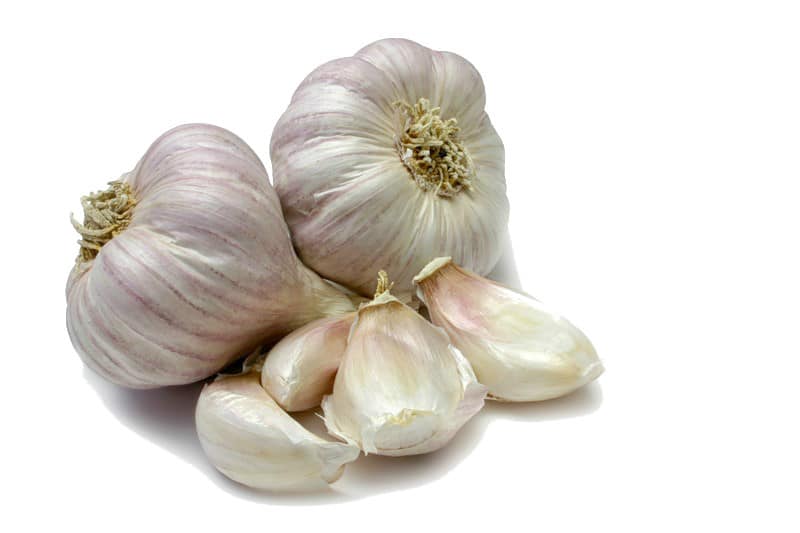 |
Boil water with garlic hulls for a decoction | ||
 |
Serum is a natural acid that is gentle on materials and metals. Used naturally | Place spoons and forks in whey for 10-12 hours and then wash with water | |
 |
Remove minor contaminants with a solution prepared from a glass of water and 3 tbsp. l. ammonia.
Remove severe blackness with concentrated ammonia |
Suitable for removing light and pronounced plaque / blackening.
Place cutlery / jewelry in solution or cover with concentrated pharmacy ammonia and leave for 1.5-2 hours, then rinse |
|
 |
No dilution or preparation required | Pour vinegar, sprite, Coca-Cola over spoons and wash after 2 hours | |
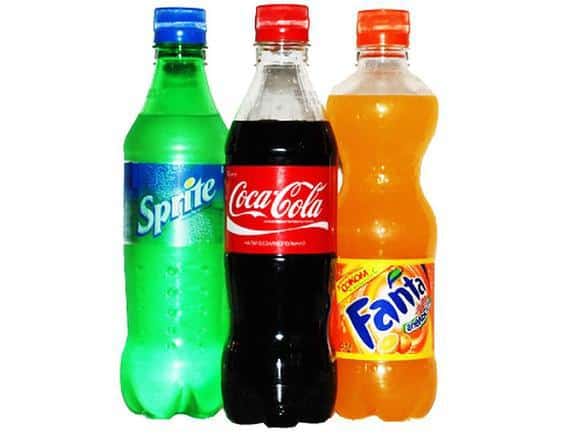 |
|||
 |
2-3 st. l. dilute in 1 liter. water. If the spoons are heavily soiled, double the citric acid concentration | Place cupronickel for 2-3 hours in the solution and wash cleaned accessories. |
After washing spoons and forks from blackness, be sure to rinse them to stop contact of the selected product with metal, and then rub until shiny and place in a prepared dry place for safe storage.
The listed ingredients are suitable for, and even.
How else can you clean cutlery, jewelry, pots from cupronickel, see the video:
Outcomes
So, should you soak the dishes or not? Soaking has advantages, but there are also disadvantages. Mostly, the procedure can harm a certain type of product. The rest of the dishes can be soaked.
There are 5 rules to follow:
- Do not place pots and pans that are still hot in water. The optimum temperature for soaking dishes is 30–40 degrees.
- Remove food debris before soaking. It is unacceptable that they float in the water and pollute it.
- Soak fatty plates after fish or other "odorous" products in a separate container, or better, wash immediately.
- Do not leave dishes in water for a long time. The optimal time is 10 minutes. After 4 hours, it will be full of germs. The source of infection in the house is useless.
- Use warm soapy water, not water. In it, impurities lag behind better and faster, bacteria proliferate less, fatty plaque dissolves more easily.



